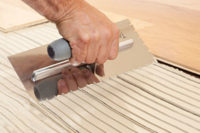Selling the Right Carpet Fiber for the Right Lifestyle


Milliken’s Crystal Stitch collection is inspired by the concept of “jewelry for the home.” The carpet is made using a Multiple Yarn Infusion technology, enabling a mix of lusters and textures.

A carpet from Shaw’s patented LifeGuard waterproof Life Happens Collection.



Many different factors must be considered when choosing the right carpet fiber for the right customer. The designated environment (whether residential or commercial), along with personal preferences—such as resiliency, durability, cost and overall aesthetic—are all crucial aspects to consider.
“The most important decision is ensuring the product you select fits the space, not only from a visual standpoint but from how the space will be utilized,” says Sherry Dreger, vice president of marketing, Bentley. “Then you can determine what construction, pattern and fiber system you want to recommend.”
Each fiber type offers specific characteristics. “For commercial interiors applications, nylon is by far the most commonly used synthetic fiber for carpets,” declares Zeftron business leader, Tim Blount. “Other fibers, such as polyester and olefin, have proven not to be as durable in these demanding end-use areas and are a more popular choice in residential carpet.”
“Nylon, polyester (PET), olefin and triexta are indeed the main types of synthetic fibers for floor covering,” states Ginny Jones, senior designer, Milliken floor covering division.
Brad Christensen, director of product management, Shaw Floors, claims, “By our estimate, polyester (PET) and nylon make up approximately 90 percent of the residential carpet market, and the two are split fairly evenly.”
While polyester is generally not as durable as nylon carpet fiber, polyester has a very high-luster appearance, translating into beautifully colored, vibrant carpets next to nylon’s more matte finishes. “Carpets made with nylon consistently perform better than polyester carpets in terms of resiliency when constructed equally,” explains Christensen. “Compression test results have shown nylon’s superiority in that regard. Nylon is particularly ideal for high traffic areas and for buyers looking for the greatest longevity in their carpeting.”
Olefin (generic for polypropylene), on the other hand, is “a moisture- and mildew-resistant fiber appropriate for more high-moisture environments, such as basements. It can also be available at a more desirable price point and naturally resists stains, but is not necessarily soil-resistant, which makes it less suitable for high-traffic areas,” Jones expressed.
Triexta (or polytrimethylene terephthalate, PTT)—the newest fiber in the carpet industry and marketed by Mohawk as SmartStrand—has been recognized as more durable and resilient than conventional polyester while also remaining significantly softer than both polyester and nylon.
“Nylon is still considered by many as the ‘best’ synthetic fiber, mainly because it has the longest history in the carpet business,” says Mike Sanderson, vice president of marketing, Engineered Floors. “Most consumers, and certainly all carpet dealers, are aware of nylon and may have a preference for it, so that’s an advantage. However, polyester has made great strides in recent years and there’s more of it, so that translates to a price advantage.”
According to Sanderson, “Many will argue that nylon is usually softer but can stain easier than polyester and that polyester is more vibrant but less soft. Our PureColor process levels the playing field for both. We make PureColor nylon—called N2—with Cationic Technology to resist staining. Both our nylon and our polyester—called P2—are treated for double the amount of soil and stain resistance.”
Weighing the pros and cons of the different fiber types, Jones states, “Nylon can offer a soft hand, is very colorfast and can hold a wide array of colors. It’s also very easy to maintain, yet conversely, can stain if not treated properly. Since olefin can attract oil—which in turn naturally attracts soil—olefin fibers are not recommended in high-traffic environments. Like olefin, polyester is more stain-resistant, but also attracts oil, and therefore it is not soil-resistant. It also doesn’t work well in high-traffic areas, as the fibers will crush and not spring back like nylon.”
Christensen notes that the biggest advantage of PET is its “value proposition” due to a lower raw material cost. Another advantage “often overlooked in piece-dyed PET is its color clarity; you naturally get more color vibrancy in piece-dyed PET than in any other fiber. However, there is still a bit of a negative stigma associated with PET as a result of historically large disparities between PET’s performance and other fibers. That gap has shrunk in recent years as the market and manufacturing processes have matured, yielding plenty of desirable PET products.”
Looking at commercial fiber performance, Blount explains, “There are two types of nylon used to construct commercial carpets—nylon 6 and nylon 6,6. From performance and aesthetic standpoints, both fiber types possess superior resilience and durability properties as well as greater styling versatility compared to other synthetic fiber types.”
Mannington Commercial’s senior process engineer, Bob Brinkley, shares a similar opinion. “It is my experience that nylon 6,6 is the best overall fiber for commercial carpet, and Lumena/Legacy is superior for wear and cleanability.”
“To find the best floor covering solution for customers, retailers should first understand the carpet’s end use and suggest constructions that will meet durability requirements over price point,” says Jones. “The location of the carpet should help retailers direct customers toward products that will satisfy them in the long-term. For example, a nylon product will be better suited for stairs over a polyester construction. Focusing on performance needs first helps the customer make a better flooring investment.”
Sanderson believes the right carpet fiber comes down to customer preference. “We tell our Dream Weaver dealers there will be some customers who will have strong opinions either way, so not to worry because with our brand you can offer them superior nylon or polyester carpets and sacrifice nothing in terms of softness, durability, stain resistance and overall quality.”
Retailers have the best opportunity to create a positive sales experience—and repeat business—by understanding the customers’ needs and priorities, notes Christensen. He recommends to ask questions including: “How do they use the room for which they are purchasing flooring? What level of maintenance do they expect? What sort of feel are they trying to create in their home? And of course, what are their budget parameters?”
He offers one more piece of advice. “It’s important for retailers to understand the attributes of not only the various fiber types but also the range of products available within each fiber type. How a carpet is manufactured, its backing and any soil/stain resistant applied as well as other factors contribute to the overall performance of the product and whether it is the best fit for that customer.”
Looking for a reprint of this article?
From high-res PDFs to custom plaques, order your copy today!










